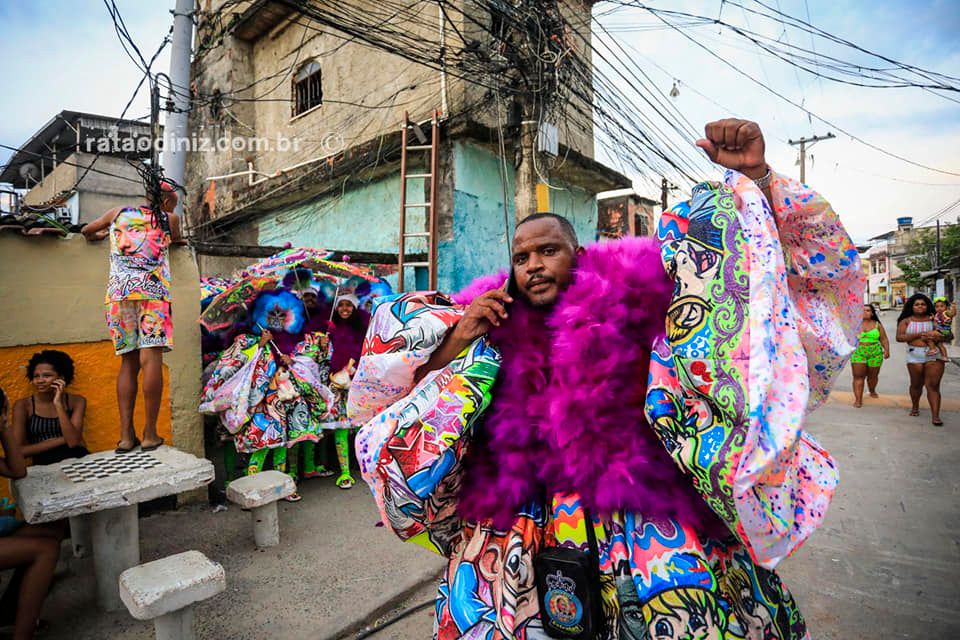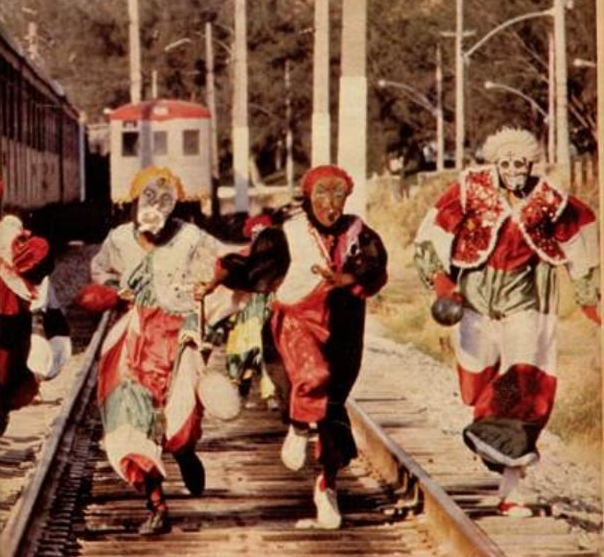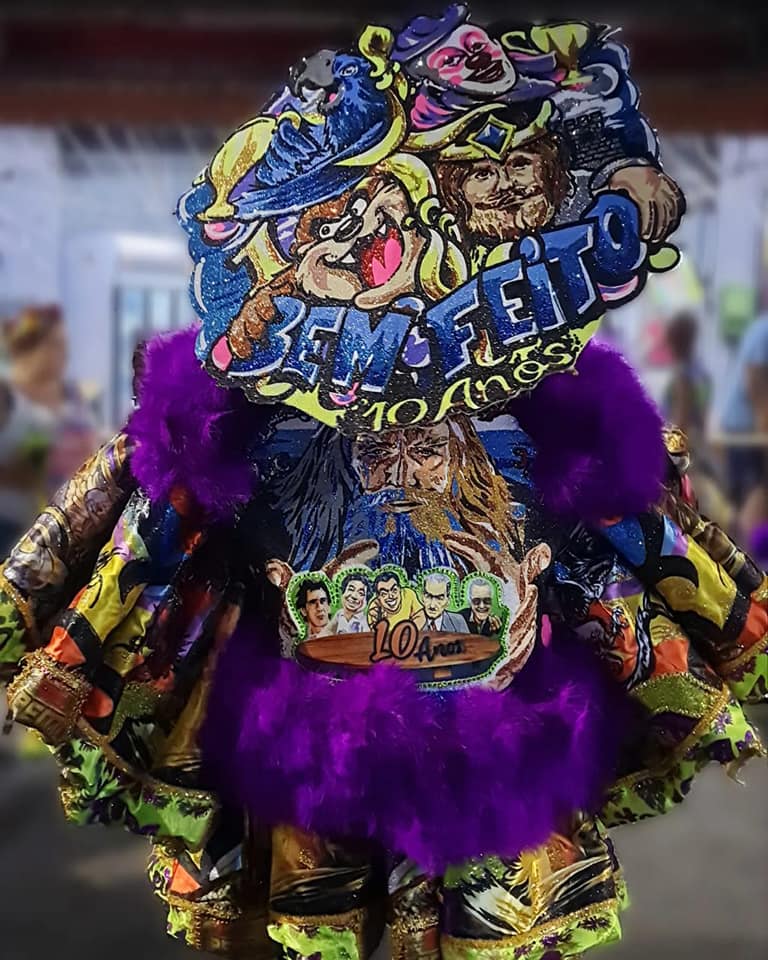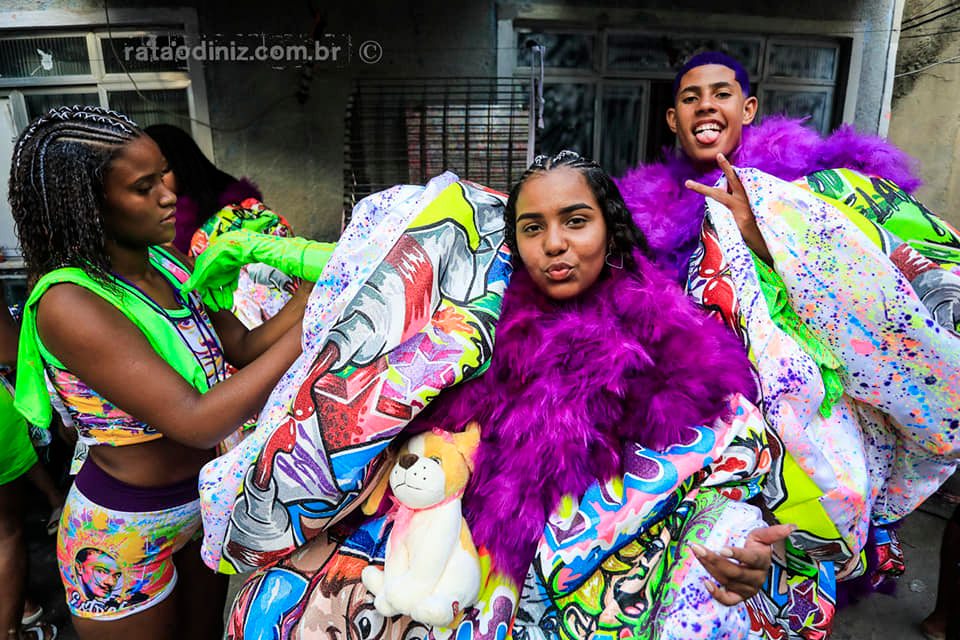
Clique aqui para Português
This is the first in a series of three articles about carnival traditions in Rio’s favelas and peripheries, respectively: the Bate-Bola clowns, an indelible tradition in the North and West Zones, and Greater Rio’s Baixada Fluminense region; the Bronze and Silver Series access groups, mostly samba schools from favelas; and Bloco Se Benze Que Dá (SBQD), a street carnival parade from Complexo da Maré. The three represent the unequal and disparate Rios that persist in (re)existing within a single city in the form of art and glitter.
Away from the spotlights of the Marquês de Sapucaí Sambadrome, the carnival of the favelas and peripheries reveals the strength of community work as a builder of the festivity. In this scenario of contrasts, residents of the favelas and peripheries of the city’s Metropolitan Region are responsible for safeguarding the traditions and popular culture of carnival. Whether out of love, passion, or activism, no one gives up on taking carnival to the streets, even with few resources.
The Bate-Bolas: Immaterial Heritage of Rio’s Peripheries

Covered from head to toe in vibrant costumes, with masks that blend the aesthetics of clowns with horror characters, the Bate-Bola groups, also known as Clóvis (an evolution of the English word “clown“), are a unique tradition of Rio de Janeiro’s carnival—a tradition from the city’s favelas and peripheries.
“I left Campo Grande when I was 14, but the Rio suburbs never left me. And the best carnival wasn’t in Campo Grande, it was in Santa Cruz. We’d spend the whole year waiting for carnival and saving money to buy the costume. And the costume to have was the Clóvis. Mine was black with yellow. It’s indescribable: the feeling of saving up that little bit of money each month, because it was expensive. And then, when carnival time came around, buying the Clóvis, putting on the outfit, and hitting the streets banging the ball on the ground, hitting it all over the place and joking with people. Nothing was as special to me as my times as a Bate-Bola. Until I was 19, I would leave wherever I was to walk the streets of Santa Cruz with my Clóvis during Carnival.” — Claudia Santiago, journalist and coordinator of the Núcleo Piratininga de Comunicação (NPC)

In addition to the masks, the Bate-Bolas are characterized by thematic and colorful costumes, which present different views on the identity of clowns, but mainly, they are known for the baton tied to a rubber ball they carry or umbrellas and staffs. In 2012, the art of the Clóvis was declared part of the city’s Immaterial Cultural Heritage.
Vibrant Street Culture and the Role of the State
In the 2024 Carnival, for the second time in history, the Bate-Bola groups of the state of Rio de Janeiro were awarded the “Bate-Bolas RJ 2” grant by the State Secretariat of Culture and Creative Economy (Sececrj). In total, R$2.5 million (US$505 thousand) were allocated to the bate-bolas, with 99 groups meeting the requirements to receive the incentive.
The initiative is part of a package of grants called “Folia RJ 2,” which was divided into three categories: “Folias de Reis RJ 2”, “Bloco nas Ruas RJ 2”, and “Turmas de Bate-Bolas RJ 2”. Together, the three grants provided a total funding of R$13 million (US$2.6 million) for Rio’s street carnival, through the selection of 311 projects, in support of the country’s largest popular festival.
The practice and culture of the Bate-Bolas is at least centenary. According to researcher and professor at the Institute of Art of the State University of Rio de Janeiro (UERJ), Aline Gualda Pereira, in the article The Bate-Bolas of Contemporary Carnival in Rio de Janeiro, the first records in the city date back to the early 20th century. Today, the culture of the Clóvis incorporates modern elements of pop culture, with costumes inspired by superheroes, movies, and cartoons. The thematic costumes are crafted using high-tech printing technology over a period of about 10 months before hitting the streets in February.
According to the researcher, the members are usually men, but there are groups with women’s and children’s sections as well. Furthermore, she notes that they are generally composed of people who live in the same neighborhood or community, aged between 25 and 40. The groups record anthems in studios and post videos on social media.
“These girls who are here helping to carry things, they also work in the workshop putting on [adornments]. It’s a victory because they used to be wives who, when their husbands went out [in the Clóvis group], got all neurotic. Then, after meeting the group, they dress up as Clóvis too and even help make the costumes. Everyone here is Bate-Bola. There are more than 30 women.” — Fabiano Lima, in the documentary, available on YouTube

In the 2024 Carnival, for example, the Turma Bem Feito, one of the largest Clóvis groups in the West Zone of Rio, with over a decade of revelry, pays tribute to the singer Marília Mendonça, who died in a plane crash. The group promises to bring 400 Bate-Bolas, including 300 adults and 100 children, to the festivities: “Marília’s 400.” The Turma Bem Feito has been crowned champion three times in the RioTur [Rio’s municipal department of tourism] Most Original Reveler Contest, which awards Bate-Bola groups: in 2015, 2019 and in 2023.
This is the first in a series of three articles about carnival traditions in Rio’s favelas and peripheries.
About the author: Tatiana Lima is a journalist, popular communicator and journalism coordinator of the Fala Roça favela newspaper from Rocinha. She has a masters degree in Media and Everyday Life from the Fluminense Federal University (UFF) where she is currently working on a PhD in Communication. A member of Complexo do Alemão’s Researchers in Movement Study Group, she also teaches reporting techniques at the Grassroots Communication Course of Núcleo Piratininga de Comunicação (NPC). A Black feminist born and raised in Favela do Quitungo and Morro do Tuiuti, Lima currently lives in Rio’s urban periphery.
